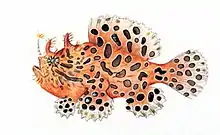Coldwater fish
Coldwater fish, in the context of aquariums, refers to fish species that do not require a heater to remain within tolerable temperatures in a typical indoor aquarium. Some examples are koi, goldfish, weather loaches, hillstream loaches, many species of barbs, sunfish of the family Centrarchidae, many Central American cichlids, and a variety of other species. Some, but not all, of these species are capable of surviving in very low temperatures, including ponds, lakes, or rivers that freeze over winter.

It is important to note that just because these fish are capable of surviving in unheated aquaria, their temperature preferences may vary. For example, koi and goldfish are commonly considered to be cold-water fish because of their ability to survive at very low temperatures, but their temperature preferences are 32°C (89.6°F)[1] and 28°C (82.4°F),[2] respectively. Because many of the ornamental fish considered to be “coldwater fish” are more accurately eurythermal fish and many prefer temperatures similar to, or even warmer than those preferred by certain tropical fish, the term “coldwater fish” in the aquarium context often misleads pet owners into keeping fish below their preferred temperature.
Freshwater aquarium fish
- Southern redbelly dace
- Lepomis
- Shubunkin
- Comet goldfish
- Common goldfish
- Fancy goldfish
- Black telescope
- Fantail goldfish
- Oranda
- Ryukin
- Weather loach
- White Cloud Mountain minnow
- Celestial Pearl Danio
- Buenos Aires tetra
- Gold barb
- Rosy barb
- Odessa barb
- Fathead minnow
- Banded corydoras
- Chinese high fin banded shark
- Three-spined stickleback
- Ticto barb
- Pygmy sunfish
- Enneacanthus
- Texas cichlid
- Paradise fish
- Green barb
- Zebra danio
- Bengal danio
- Leopard danio
- Bulldog pleco
- Rhinogobius
- Desert goby
- Highland swordtail (Xiphophorus malinche)
- Japanese ricefish
- Zacco
- Black lined loach (Yasuhikotakia nigrolineata)
- Red shiner (Cyprinella lutrensis)
- Spotted gar
- Longnose gar
- Rosy red minnow
- Hillstream loach
- Spined loach
- Stone loach
- Common minnow
- Vietnamese cardinal minnow
- GM glowing medaka
- Gobio
- Amur bitterling
- Rosy bitterling
- Light's bitterling
- Deep bodied bitterling
- Rainbow shiner (Notropsis chromosus)
- Black shark (not to be confused with the tropical red tailed black shark)
- Golden cobra snakehead
- Dwarf snakehead
- Rainbow snakehead
- Spotted snakehead (Channa punctata)
- Pearl danio
- Northern snakehead
- Chinese algae eater
- Variable platyfish
Note: The above contains a mix of true coldwater fish and sub-tropical fish that can survive and thrive at room temperature which ranges from 15 °C (59 °F) and to 30 °C (86 °F).[3]
Freshwater pond fish
- Three-spined stickleback
- Nine-spined stickleback
- Common goldfish
- Shubunkin
Marine aquarium fish
Wild fish
The term is also used to refer to fish species in the wild (such as lake trout, Arctic char, and Arctic grayling), that prefer colder waters.
References
- Pitt, T. K.; Garside, E. T.; Hepburn, R. L. (1956-12-01). "Temperature Selection of the Carp (cyprinus Carpio Linn.)". Canadian Journal of Zoology. 34 (6): 555–557. doi:10.1139/z56-055. ISSN 0008-4301.
- Reynolds, William W.; Casterlin, Martha E. (1979-07-01). "Effect of temperature on locomotor activity in the goldfish (Carassius auratus) and the bluegill (Lepomis macrochirus): Presence of an 'activity well' in the region of the final preferendum". Hydrobiologia. 65 (1): 3–5. doi:10.1007/BF00032711. ISSN 1573-5117. S2CID 24347838.
- "Definition of ROOM TEMPERATURE". www.merriam-webster.com.
Marine Aquarium Fish - http://www.oregonreef.com/sub_coldwater.htm
Freshwater Aquarium Fish - Practical Fishkeeping Magazine
Freshwater Pond Fish - An Essential Guide to Choosing Your Pond Fish and Aquatic Plants by Graham Quick and also http://www.pondexpert.co.uk/ChoosingTheRightFishForYourPond.html
